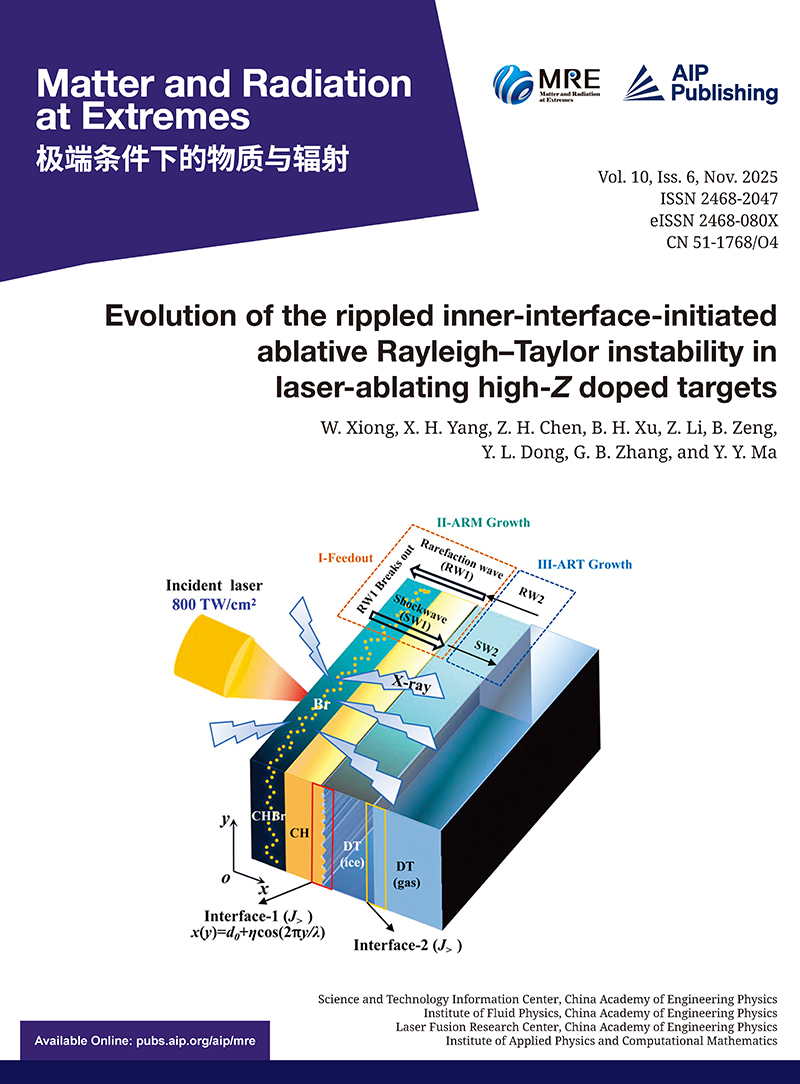On this page: Focus and Coverage | Editorial Policies
Matter and Radiation at Extremes (MRE), is committed to the publication of original and impactful research and review papers that address extreme states of matter and radiation, and the associated science and technology that are employed to produce and diagnose these conditions in the laboratory. Drivers, targets and diagnostics are included along with related numerical simulation and computational methods. It aims to provide a peer-reviewed platform for the international physics community and promote worldwide dissemination of the latest and impactful research in related fields.
Matter and Radiation at Extremes covers a broad range of important research in the following topics:
Fundamental Physics at Extreme Light
● Ultra-high intensity laser-matter/plasma interaction
● Laser-induced QED effects, QED plasma physics
● Relativistic optics and plasma optics
● New sources of intense particles, X-rays and gamma-radiation
● Non-LTE transport/physics
● Short-pulse laser physics
● Relativistic laboratory astrophysics
● Nuclear photonics
Inertial Confinement Fusion Physics
● Laser and particle beam fusion physics
● Magnetic driven fusion
● Laser-plasma interaction
● Diagnostics
● Targetry
● Lasers and optics for ICF
● Alternative ICF
● Pulsed power technology for ICF
Radiation and Hydrodynamics
● Laboratory astrophysics
● Atomic physics in HEDP
● Warm dense matter
● Hydrodynamic instabilities and turbulence
● Shocks and planetary physics
● Interaction of radiation with matter
● Magnetized plasmas
● HED Physics on XFEL
High Pressure Physics and Materials Science
● High-pressure technology and probes
● Condensed-matter physics under compression
● Superconductivity under compression
● Low-dimensionality materials under compression
● Dense amorphous materials
● High-pressure chemistry
● Earth’s and planetary deep interiors
● Superhard materials
● Dense energetic materials
● High-pressure functional materials
Open Access Statement
Matter and Radiation at Extremes (MRE) is an open access journal. Articles published in MRE are freely accessible, without restriction, to the global public. Although MRE is an open access journal, authors are not responsible for any publication charges. The open access publication fee is funded by the Science and Technology Information Center, China Academy of Engineering Physics. Authors who publish in MRE retain the copyright to their work under a Creative Commons license. Under this license, users are free to share and adapt the material in any format, provided appropriate credit is given. Visit the AIP Publishing Open Access Policy for more information about our policies on open access.
MRE- Journal Impact Factor
Journal Citation Reports™ from Clarivate, 2021*:
| Five-Year Impact Factor | 3.911 |
| Impact Factor | 2.845 |
| Immediacy Index | 1.821 |
| Cited Half-Life | 3.0 |
| EigenFactor Score | 0.00158 |
| Article Influence Score | 1.238 |
* Data from the Journal Citation Reports™ from Clarivate, 2021.
ISSN: 2468-080X
CODEN: MREAE5
Publication Standard
Matter and Radiation at Extremes (MRE) offers rapid publication of original and impactful research and review papers that address extreme states of matter and radiation, and the associated science and technology that are employed to produce and diagnose these conditions in the laboratory.
MRE’s publications should meet one or more of the following standards:
● Contain novel researches that contribute in a noticeable way to advanced science, technology and infrastructures in the context of matter and radiation at extreme conditions.
● Make significant advance in solving critical problems or improving scientific understanding or present an original approach to existing issues by throwing light on it from a different angle.
● Develop innovative techniques or theoretical models with significant impact.
Language Standards
It is the author’s responsibility to ensure that manuscripts are written clearly. Authors, whose native language is not English, are advised to have their manuscripts edited by an English-speaking colleague or a professional editing service provider before the initial submission. AIP Author Services can help improve the quality of your written English after final acceptance.
Article Types
Matter and Radiation at Extremes (MRE) publishes Reviews, Research Articles, and Letters. MRE also publishes Comments on previously published manuscripts and Errata.
Research Articles are original contributions with accurate and authentic data that include new research findings that constitute a substantial advance in understanding a subject within the scope of the journal.
Letters are the flagship article type of MRE, which are meant to provide rapid dissemination of innovative and time-sensitive new results in the fields regularly covered by MRE, in the form of a condensed communication. The article length limit is 4000 words maximum. Letters are published as a separate entity, not included in the five MRE columns.
Reviews are comprehensive and provide an in-depth overview of a particular topic of importance within the field.
Perspectives are Invited papers on topics related to MRE that are currently generating a great deal of interest in the community, aiming to provide an objective and balanced overview of recent advances and the author’s unique view on where the field is heading.
Comments are used to correct significant errors in articles published in the journal, rebut conclusions reached, or to provide additional insight or corroboration. Comments must address scientific issues only and be concise, substantive, and respect polite scientific conduct. We discourage comments on questions of priority or calling attention to an oversight in a reference list. Generally, the Editor will invite the authors of the targeted Comment to respond in print. The editor may decide to accept Comments and Responses, if any, for publication only after the two parties have submitted final versions of their pieces. The editor-in-chief reserves the right to send Comments and Responses to an adjudicator or to reject one or both for publication.
Errata are used by authors to correct significant errors of substance in their published manuscripts. These can be errors accidentally introduced into the article during the publication process or errors in the research that were discovered after publication. Further discussion or additional work that either confirms or denies the previous work should be presented as a separate Article or Comment. Errata should be clear and concise.
Submission of Manuscript
Manuscripts should be submitted via Peer X-Press. After you log in Peer X-Press, you will see a link to author instructions. You can use Peer X-Press to check the status of your submitted manuscript.
Manuscripts must be submitted by a single corresponding author. In all transactions regarding a manuscript, initial submission and all revisions, the corresponding author must act with the knowledge and permission of all coauthors.
Authors must sign the License to Publish Agreement electronically when they submit the manuscript.
Ethics and Responsibilities of Authors
By submitting a manuscript to this journal, each author explicitly confirms that the manuscript meets the highest ethical standards. A detailed statement of what the journal expects can be found here.
Peer Review Procedure
Matter and Radiation at Extremes operates a single blind review process. All contributions will be initially assessed by the editor for suitability for the journal. Papers deemed suitable are then typically sent to a minimum of two independent expert referees to assess the scientific quality of the paper. The Editor reserves right for the final decision regarding acceptance or rejection of articles. The referees’ judgement is not binding for the editor. The Editor’s decision is final.
The Editor makes decisions regarding the acceptability of manuscripts based on the comments and conclusions of referees. The Editor decides which comments, either positive or negative, to accept and also when they have received sufficient comments to make a decision. When two referees give opposite conclusions about the manuscript, it is recommended the editor invites additional referees.
Authors of manuscripts subject to revisions should address the comments of the referees and the editor in the response letter. If they agree with the comment, they revise the manuscript accordingly and explain the revision; if they disagree with the comment, they justify in detail their reasons for the disagreement. In cases of disagreement, the editor will decide whether the advice of an additional referee is necessary.
The additional referees will usually receive anonymous copies of the previous referees’ comments, along with the authors’ rebuttal. The Editor monitors the review procedure and makes the final decision.
Authors may appeal a decision to reject a manuscript. If the editor feels that an author has made a plausible argument for reconsideration, he/she may seek further advice from additional referees acting in the usual or in an adjudicating way. In some cases, the editor may ask another editor to review the entire manuscript history.
To further appeal a decision to reject a manuscript, authors must request that the editor ask the publisher at AIP Publishing to review the case. The publisher does not decide whether a manuscript should be accepted for publication, but rather assesses whether the procedures were followed properly. Additional rounds of review or adjudication would be called for only if proper procedures were not followed.
Retraction and Correction Policies
AIP Publishing’s policy is based on best practices in academic publishing. We take seriously our responsibility to maintain the integrity and completeness of the scholarly record of our content. We place great importance on the authority of articles after we publish them. Authors may make changes to articles after they have been published online only under the circumstances outlined in AIP Publishing’s Retraction and Correction Policies.







